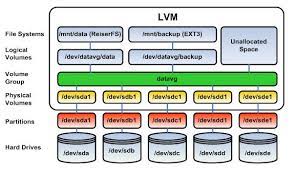Linux LVM, or Logical Volume Manager, is a tool for managing disk storage in Linux systems. It provides a way to divide a single physical storage device, such as a hard drive, into multiple logical storage units called logical volumes. This allows you to manage your disk space more flexibly by enabling you to easily resize, create, and delete logical volumes as needed. Additionally, LVM allows you to combine multiple physical storage devices into a single logical volume, which can make it easier to manage your storage and improve performance. Overall, LVM is a powerful tool for managing disk storage in Linux systems.
To use LVM for partitioning, you can use the following commands:
fdisk: This command is used to create new partitions on a disk.
pvcreate: This command is used to create a physical volume on a disk or partition.
vgcreate: This command is used to create a new volume group using one or more physical volumes.
lvcreate: This command is used to create a new logical volume within a volume group.
mkfs: This command is used to create a filesystem on a logical volume.
mount: This command is used to mount a filesystem so that it can be accessed by the operating system.
Here is an example of how you might use these commands to partition a disk using LVM:
Use the fdisk command to create a new partition on the disk.
Use the pvcreate command to create a physical volume on the new partition.
Use the vgcreate command to create a new volume group using the physical volume.
Use the lvcreate command to create a new logical volume within the volume group.
Use the mkfs command to create a filesystem on the logical volume.
Use the mount command to mount the filesystem so that it can be accessed by the operating system.
